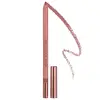What's inside
What's inside
 Key Ingredients
Key Ingredients

 Benefits
Benefits

 Concerns
Concerns

 Ingredients Side-by-side
Ingredients Side-by-side

Dimethicone
EmollientTrimethylsiloxyphenyl Dimethicone
Diisostearyl Malate
EmollientSynthetic Wax
AbrasiveTrimethylsiloxysilicate
EmollientOctyldodecanol
EmollientDicalcium Phosphate
AbrasiveC20-24 Alkyl Dimethicone
Skin ConditioningSimmondsia Chinensis Seed Oil
EmollientCopernicia Cerifera Wax
Punica Granatum Flower Extract
Skin ConditioningMoringa Oleifera Seed Oil
EmollientPolyglyceryl-3 Diisostearate
EmulsifyingDisteardimonium Hectorite
StabilisingPropylene Carbonate
SolventPentaerythrityl Tetra-Di-T-Butyl Hydroxyhydrocinnamate
AntioxidantCI 77891
Cosmetic ColorantCI 77491
Cosmetic ColorantCI 77492
Cosmetic ColorantCI 77499
Cosmetic ColorantCI 42090
Cosmetic ColorantCI 15850
Cosmetic ColorantDimethicone, Trimethylsiloxyphenyl Dimethicone, Diisostearyl Malate, Synthetic Wax, Trimethylsiloxysilicate, Octyldodecanol, Dicalcium Phosphate, C20-24 Alkyl Dimethicone, Simmondsia Chinensis Seed Oil, Copernicia Cerifera Wax, Punica Granatum Flower Extract, Moringa Oleifera Seed Oil, Polyglyceryl-3 Diisostearate, Disteardimonium Hectorite, Propylene Carbonate, Pentaerythrityl Tetra-Di-T-Butyl Hydroxyhydrocinnamate, CI 77891, CI 77491, CI 77492, CI 77499, CI 42090, CI 15850
Dimethicone
EmollientTrimethylsiloxysilicate
EmollientSynthetic Wax
AbrasiveMica
Cosmetic ColorantDicalcium Phosphate
AbrasivePhenylpropyldimethylsiloxysilicate
EmollientCI 77891
Cosmetic ColorantPolyethylene
AbrasiveCI 77492
Cosmetic ColorantAcrylates/Stearyl Acrylate/Dimethicone Methacrylate Copolymer
Polyhydroxystearic Acid
EmulsifyingCI 77491
Cosmetic ColorantDisteardimonium Hectorite
StabilisingAluminum Hydroxide
EmollientCaprylyl Methicone
Skin ConditioningCaprylic/Capric Triglyceride
MaskingCI 15850
Cosmetic ColorantCI 42090
Cosmetic ColorantPropylene Carbonate
SolventPentaerythrityl Tetra-Di-T-Butyl Hydroxyhydrocinnamate
AntioxidantTocopherol
AntioxidantCI 15985
Cosmetic ColorantCI 19140
Cosmetic ColorantRubus Idaeus Leaf Extract
Skin ConditioningDimethicone, Trimethylsiloxysilicate, Synthetic Wax, Mica, Dicalcium Phosphate, Phenylpropyldimethylsiloxysilicate, CI 77891, Polyethylene, CI 77492, Acrylates/Stearyl Acrylate/Dimethicone Methacrylate Copolymer, Polyhydroxystearic Acid, CI 77491, Disteardimonium Hectorite, Aluminum Hydroxide, Caprylyl Methicone, Caprylic/Capric Triglyceride, CI 15850, CI 42090, Propylene Carbonate, Pentaerythrityl Tetra-Di-T-Butyl Hydroxyhydrocinnamate, Tocopherol, CI 15985, CI 19140, Rubus Idaeus Leaf Extract
Ingredients Explained
These ingredients are found in both products.
Ingredients higher up in an ingredient list are typically present in a larger amount.
Ci 15850 is the pigment color red. It is an azo dye and created synthetically.
Azo dyes need to be thoroughly purified before use. This allows them to be more stable and longer-lasting.
This ingredient is common in foundations, lipsticks, and blushes. This color is described as brown/orangey red.
It has many secondary names such as Red 6 and Red 7. According to a manufacturer, Red 6 usually contains aluminum.
Learn more about CI 15850Ci 42090 is a synthetic dye created from petroleum. It is used to give a bright blue color to cosmetics, medicine, and food.
Ci 77491 is also hydrated iron III oxide. It's sole purpose is to give a red/pink hue to products.
Iron III oxides are classified as inorganic chemicals for coloring.
Synthetically created Ci 77491 is considered safer than those naturally found. This is because the synthetically created version may contain less impurities. Iron oxides are generally non-toxic and non-allergenic.
Learn more about CI 77491Ci 77492 is also hydrated iron III oxide. It's sole purpose is to give a yellow hue to products.
Iron III oxides are classified as inorganic chemicals for coloring.
Synthetically created Ci 77492 is considered safer than those naturally found. This is because the synthetically created version may contain less impurities. Iron oxides are generally non-toxic and non-allergenic.
Learn more about CI 77492Ci 77891 is a white pigment from Titanium dioxide. It is naturally found in minerals such as rutile and ilmenite.
It's main function is to add a white color to cosmetics. It can also be mixed with other colors to create different shades.
Ci 77891 is commonly found in sunscreens due to its ability to block UV rays.
Learn more about CI 77891Dicalcium Phosphate is an exfoliant.
Dimethicone is a type of synthetic silicone created from natural materials such as quartz.
What it does:
Dimethicone comes in different viscosities:
Depending on the viscosity, dimethicone has different properties.
Ingredients lists don't always show which type is used, so we recommend reaching out to the brand if you have questions about the viscosity.
This ingredient is unlikely to cause irritation because it does not get absorbed into skin. However, people with silicone allergies should be careful about using this ingredient.
Note: Dimethicone may contribute to pilling. This is because it is not oil or water soluble, so pilling may occur when layered with products. When mixed with heavy oils in a formula, the outcome is also quite greasy.
Learn more about DimethiconeDisteardimonium Hectorite comes from the clay mineral named hectorite. It is used to add thickness to a product.
It can also help stabilize a product by helping to disperse other ingredients.
Hectorite is a rare, white clay mineral.
Learn more about Disteardimonium HectoritePentaerythrityl Tetra-Di-T-Butyl Hydroxyhydrocinnamate (long name, huh?) is a synthetic antioxidant.
It is used to help stabilize other antioxidants or prevent the color from changing in a product.
As an antioxidant, it helps fight free-radical molecules. Free-radical molecules are capable of damaging our cells and other genetic material. Thus, antioxidants may reduce the signs of aging.
This ingredient is oil-soluble.
Learn more about Pentaerythrityl Tetra-Di-T-Butyl HydroxyhydrocinnamateThis ingredient is a solvent. It helps dissolve active ingredients and alter the texture of products.
Propylene Carbonate is commonly used in makeup and with clay, such as montmorillonite or bentonite.
Studies show this ingredient to be safe for cosmetics. When it is undiluted, it can cause skin irritation. (It is always diluted in skincare and makeup). This ingredient is water-soluble.
Propylene Carbonate is created from propylene glycol and carbonic acid.
Learn more about Propylene CarbonateSynthetic Wax is created from fossil fuels such as natural gas. It is used to enhance texture, adjust pH, and as an occlusive.
It may also be used as an abrasive ingredient to exfoliate the skin.
Synthetic Wax may not be fungal acne safe.
Learn more about Synthetic WaxThis silicone is an emollient. Emollients create a thin film on the skin to prevent moisture from escaping.
It is not soluble in water and helps increase water-resistance in products.
According to a manufacturer, it can blend seamlessly with silicone oils, such as Cyclopentasiloxane.
Learn more about Trimethylsiloxysilicate